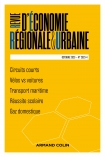
Revue d'économie régionale et urbaine (2/2023)
Pour acheter ce numéro, contactez-nous
Recevez les numéros de l'année en cours et accédez à l'intégralité des articles en ligne.
Cet article s’intéresse à la répartition spatiale des exploitations agricoles commercialisant tout ou partie de leur production en circuit court (CC). L’objectif est d’identifier, à l’aide de l’économétrie spatiale les facteurs déterminants du choix de diversification dans les circuit court pour les agriculteurs, afin de voir s’il existe ou non un effet de la localisation des exploitations. La méthode consiste à dresser une typologie des territoires, en prenant en compte, notamment, plusieurs types d’accessibilité potentielle, et à utiliser cette typologie pour étudier la répartition spatiale des exploitations agricoles en CC. Les résultats montrent qu’en plus des variables décrivant les agriculteurs et les exploitations agricoles, les variables décrivant le territoire où se trouvent les fermes sont elles aussi déterminantes dans le choix de vendre en CC. Les territoires avec les plus grandes proportions de fermes en CC sont des territoires ruraux enclavés ainsi que des territoires périurbains très denses, où l’accessibilité aux populations est la plus élevée. Le point commun de ces territoires est la faible occupation du sol en agriculture, à cause des contraintes naturelles pour les espaces ruraux enclavés et de pressions foncières dans les territoires périurbains denses. On retrouve donc plus de fermes en CC dans les cantons où l’agriculture est marginale. Cet article illustre ainsi de l’existence de liens entre accessibilité à de grands bassins de populations et vente en CC en 2010 et d’une forme de résistance de ces fermes à l’urbanisation (Brinkley, 2018).
In the context of the implementation of public policies to develop and support sustainable food systems, this article focuses on the spatial distribution of farms selling all or part of their production in short food supply chains (SFSCs). The objective of the study is to identify econometrically the determining factors of the choice of diversification in SFSCs for farmers, in order to see whether there is an effect of the location of farms on the choice to sell in SFSCs. The method consists of drawing up a typology of territories, taking into account different types of variables of potential accessibility of farms to consumers, and using this typology to study the spatial distribution of farms in SFSCs. Using these variables, we calculate OLS and SDEM models. The results show that in addition to the variables describing the farmers and the farms found in the literature, the variables describing the territories where the farms are located are also decisive in the choice to sell in SFSCs. The territories where there are the highest proportions of SFSCs farms are landlocked rural territories, isolated from consumption areas, as well as very dense peri-urban territories, where accessibility to populations is the highest. The common point of these territories is the low occupation of the land in agriculture, because of the natural constraints for the landlocked rural spaces, and because of land pressures in the dense peri-urban territories. There are thus more SFSCs farms in cantons where agriculture is marginal. This article thus illustrates the effective links between accessibility to large population pools and SFSCs sales in 2010, and a form of resistance of these farms to urbanization (Brinkley, 2018).
